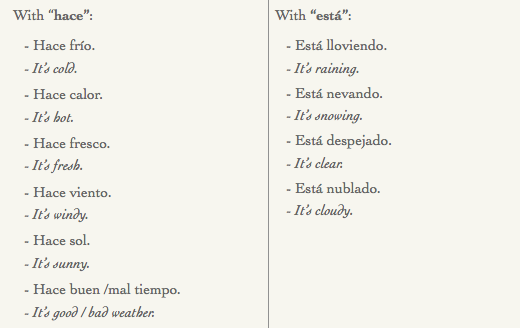Talking about the weather is a very handy topic in every language when you don’t know what to say. Here, I am going to give you all the vocabulary necessary to solve any uncomfortable silence in the lift.
But before we get into that, let me tell you that “weather” and “time” are the same word in Spanish: el tiempo.
When you are talking with someone living in another city or country, and you want to ask what the weather is like over there, you can ask:
- ¿Qué tiempo hace (por allí)?
- What’s the weather like (over there)?
o
- ¿Cómo hace?
- How’s the weather?
When you are with someone and want to make small talk (literally in Spanish, the translation in Spanish of “making small talk” is “hablar del tiempo” or “charlar/hablar de cosas sin importancia”) you can start the conversation with:
- ¡Menudo día tenemos hoy!
- What a day we have today!
Which you can use for a good day or a bad day, it depends on the weather! 😀 But if you want to be more precise, what about:
- Menudo día de lluvia tenemos!
- What a rainy day!
o
- Menudo día de sol / calor / frío…!
- What a sunny / hot / cold… day!
Add a “¿no?” at the end of that intervention, and, voilá, you have started the conversation. Now it’s the ball is on the other’s person’s roof.
Let’s see some ways to continue with the conversation:
Weather conditions
Condiciones meteorológicas

To nuance the weather conditions, you can use “mucho” o “poco” for “hace” and “muy” for “está” right after the verb. Although if the word that follows “está” is a verb, then you can’t use “muy” but “mucho” and you will have to add it after the verb.
Look at the examples to see what it looks like:
- Hace mucho frío.
– It’s very cold. Hace poco calor.
– It’s a little hot.Está muy despejado.
– It’s very clear.Está lloviendo mucho.
– It’s raining a lot.
To express the negative of all these ideas, you just need to add “no” in front of the verb.
- No está nevando mucho.
– It’s not snowing a lot.
A bit of vocabulary:
- lloviznar > ‘to drizzle’
- granizar > ‘to hail’
- llover > ‘to rain’
- nevar > ‘to snow’
- bochorno > ‘muggy weather’
Remember than all this verbs are only in the 3rd person: llovizna (it drizzles), graniza (it hails), llueve (it rains) and nieva (it snows).
To talk about the existence of any weather condition, you can use the verb “hay”.
- Hay mucho viento.
– There is a lot of wind. Hay mucha nieve.
– There is a lot of snow.Hay niebla.
– It’s foggy.
- Expressions about the weather.
Llueve a cántaros = Jarrea (literally means: it’s raining jugs full).
– It’s pouring.Hace un frío que pela.
– It’s freezing.Hace un calor abrasador / achicharrante.
– It’s scorching.Hace un calor que se caen los pájaros (literally menas: it’s so hot that the birds fall down).
– It’s very, very hot.
And here you have it, some structures and vocabulary to talk about the weather in Spanish.


